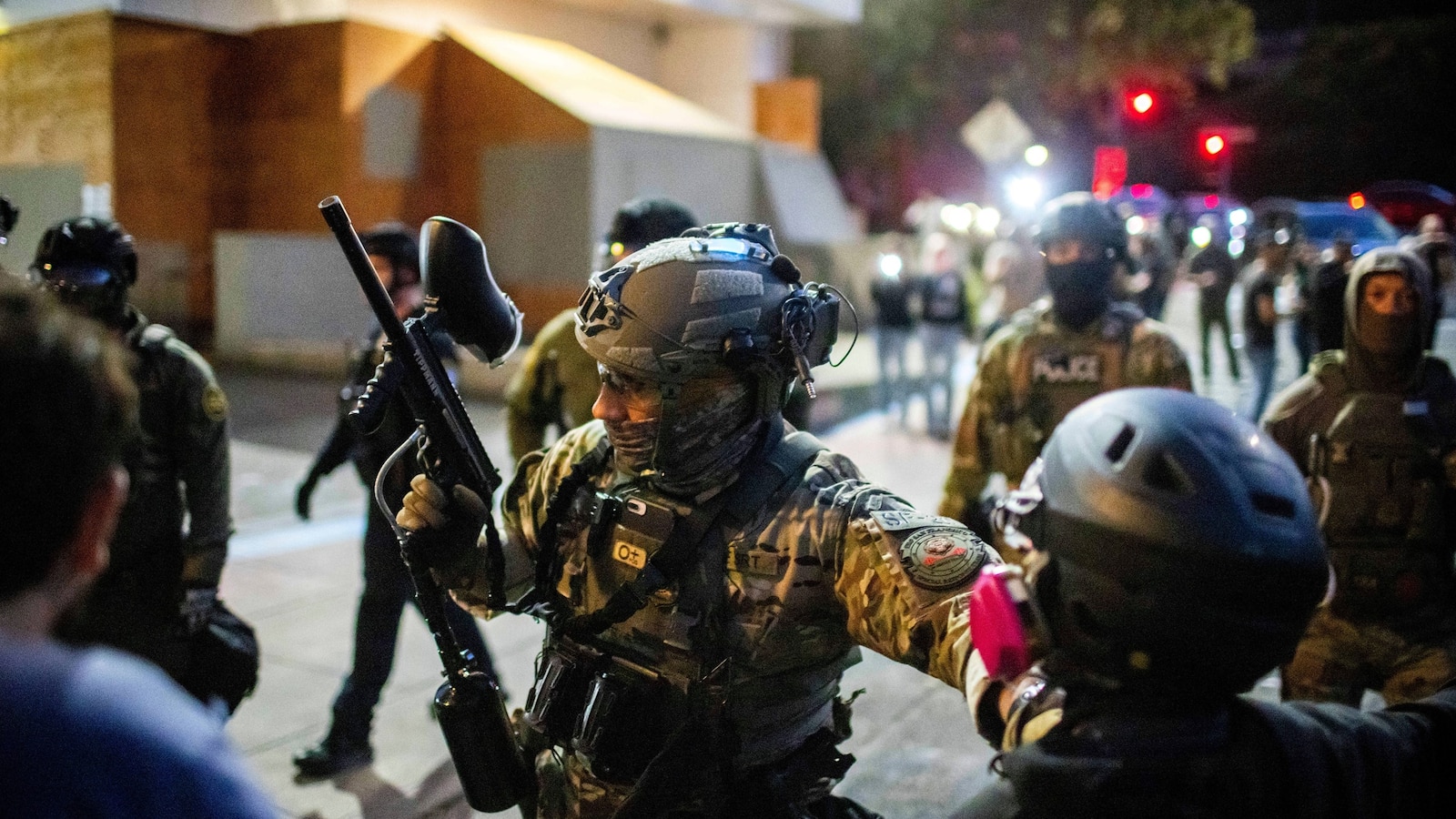The signs range in style and mark numerous locations where people have been taken by federal agents.
The signs — nailed to trees or wrapped around electricity poles — have appeared across some of the District’s heavily immigrant neighborhoods, marking the anger in a majority-Democratic city where federal immigration arrests have escalated.
“ICE kidnapped a community member here,” reads one. “Never forget/no nos olvidamos,” says another.
Barbara McCann, a city resident for 25 years, created one in August after she came upon a crowd of shouting people and broken glass on the street in her Columbia Heights neighborhood, where federal law enforcement agents had pulled two men from their car.
“People were kidnapped here this morning by ICE or ?” she wrote on the sign. “BANG pots HERE tonight 8pm.”
McCann said later that she thought of “stumbling stones” in Europe, the brass-topped cobblestones that have been placed in front of the former homes and businesses of those who were killed in the Holocaust.
“They are targeting those who are least able to defend themselves, people without homes and people without documentation,” she said. “In the past, when there’s been great injustice, moral clarity takes a long time.”
D.C. has a long tradition of protesting, including the massive marches during President Donald Trump’s first administration. The recent neighborhood signs, more personal and isolated, follow an older tradition of simply bearing witness — in this case, to the arrests of immigrants who make up the fabric of some neighborhoods.
Since late August, when Trump’s 30-day crime emergency in D.C. was in full effect, more than 11 signs and posters memorializing those arrested have appeared in neighborhoods such as Columbia Heights or Brightwood in Northwest Washington.
It’s unclear how much coordination there is between the different sign makers. Some messages are printed on 18-by-24-inch yard signs or smaller placards; others are drawn ornately by hand on paper or written in chalk. The few who will talk about the signs they created say the urgency of the moment compelled them to act.
White House officials said in a statement last month that of more than 2,600 criminal arrests between Aug. 7 and Sept. 14, more than 1,000 involved “illegal aliens.” Attorney General Pam Bondi said D.C.’s lenient policies toward immigrants, which prohibited police from cooperating in ICE arrests, made the city more dangerous.
White House spokeswoman Abigail Jackson told The Post in an email that ICE officers are facing an increase in assaults because of “untrue smears like false claims that they are ‘kidnapping’ people.’ ”
ICE has acted “heroically” and “with the utmost professionalism,” she said, and that those accusing agents of violating civil rights are sympathizing with undocumented immigrants and criminals.
Neighbors on Holmead Place in Columbia Heights say three masked agents in tactical vests tackled a man on the sidewalk in late August. As they struggled, onlookers gathered nearby, some with children dressed for the first day of school. According to five people who said they witnessed the event, the agents loaded the man into one of three unmarked cars with tinted windows and drove away.
In the days that followed, residents say they spotted a poster on Holmead Place NW, fastened by screws into a sycamore tree. It described the Aug. 25 arrest of “Angel H.” and the words “Never forget.”
Jacob Stokes, who witnessed the arrest with his wife that morning, came upon the sign while on a walk. Like McCann, he also thought of the stumbling stones and “remembering and associating an event with a particular place.”
“I’m not on the list of people who they’re coming for now,” he said. “It reminded me that those people are our neighbors.”
He and his family have lived in Columbia Heights since May. And he says it’s been quieter than other D.C. neighborhoods where he’s lived in previous years — until the past few months.
Jessica Loya remembers running down from her Brightwood apartment at the sound of a distressed voice outside her window on the morning of Aug. 22. She found her building’s handyman surrounded by three federal agents.
She said he told her in Spanish that he’d gone to his car to get a tool when he was stopped. She and others questioned the officers to understand why he had been approached.
“You can’t tell us what we’re going to do and what we’re not going to do,” a masked officer told Loya, according to video obtained by The Post. The video shows that officers shoved the handyman toward an unmarked vehicle and handcuffed him, then put him in a car and drove away.
Tricia McLaughlin, a spokeswoman for the Department of Homeland Security, said the handyman had entered the country illegally from Guatemala at an unknown date.
“ICE is not ‘kidnapping’ illegal aliens,” she said in an email. “These smears are leading to our officers facing a 1000% increase in assaults against them including terrorist attacks, cars being used as weapons, and bounties on their heads.”
The next day, Loya said she stared at the spot where the handyman had stood and added that the flashbacks of his disappearance were “unbearable.” She worked late into the night with Julio Obscura, an artist and friend, to design a sign.
At one point, she considered the monarch butterfly symbol often associated with migrant advocacy groups, but felt the positive feeling wasn’t fitting for the moment.
“What I was trying to capture here in the sign was this terror,” she said.
They settled on the black sign with bold white lettering: “ICE kidnapped a community member here.”
Loya ordered three at a cost of $297.86 and picked them up from a printer three days later. With her landlord’s blessing, she planted one of them next to her building and kept the others in case the first one was damaged or stolen.
Her voice buckled as she talked about the handyman’s family. His wife is terrified, she said, and his three children, who all are younger than 10, don’t understand what’s happened to their father.
Loya said she has been helping the family since he was detained, hoping to show them “not every U.S. citizen believes in what this administration is doing.”
Polling shows Americans overall are split on whether immigrants deported by the Trump administration should have been removed. A majority of D.C. residents oppose D.C. police helping with deportations, according to a Washington Post-Schar School poll.
Another man was working as an Uber driver when he was detained by federal agents and D.C. Police on 8th and Tuckerman Street the night of Aug. 26. Council member Janeese Lewis George (D-Ward 4) rushed to the intersection and began live-streaming the arrest.
Lewis George told The Post she couldn’t get information about the man at the time of his apprehension and was unable to locate him in nearby police precincts afterward. His car and phone were left behind, she said, so neighbors were able to make contact with a friend.
“There was a moment where, like, is this really happening to us?” Lewis George said. “I kept thinking, like, Oh, my God, are our neighbors going to have to end up in our basements and attics?”
Former Advisory Neighborhood Commission member Sophia Tekola — who said she spoke to the man in Amharic and has been in touch with his family — learned that he’d been detained in a facility outside Washington and was released the next day.
Loya, who saw Lewis George’s live stream of the arrest, rushed up the street that same night with her extra signs from the incident with her building’s handyman and approached a neighbor lingering nearby.
“I think it’s important to put these up,” Loya told the woman. The neighbor fastened the memorial to a tree in her yard, near the spot where the man had been arrested.
The next day, the council member took to social media and made a six-minute, 34-second video urging her followers to call their representatives. As Lewis George spoke, a photo of Loya’s black and white memorial was visible in the background.
Shows of disapproval and protest of Trump and his administration’s policies haven’t matched the volume seen in Trump’s previous term despite concerns about potential abuse of power. For people like Loya and McCann, who have spent years in a town known for its statues and monuments, the act of remembering those taken away isn’t just an act of empathy — it’s a signal.
McCann said she’s long had an interest in history. This moment in the city has made her reflect on what may lie ahead for it and the country, she said.
“What I always have on my mind is like, well, what’s next?” she said.








